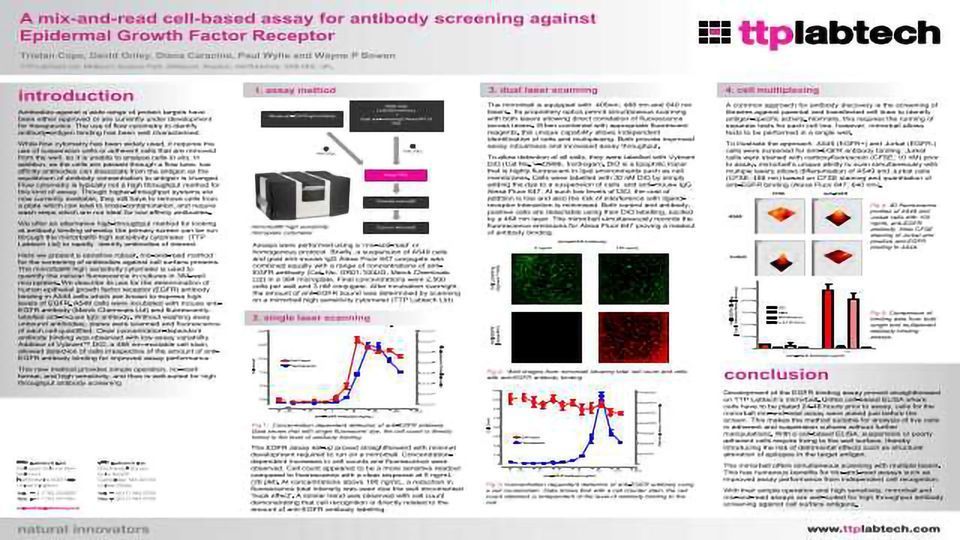A mix-and-read cell-based assay for antibody screening against Epithelial Growth Factor Receptor

Antibodies against a wide range of protein targets have been either approved or are currently under development for therapeutics. The use of flow cytometry to identify antibody-antigen binding has been well characterised. While flow cytometry has been widely utilised, it requires the use of suspension cells or adherent cells that are removed from the well, so it is unable to analyse cells in situ. In addition, as the cells are passed through a flow tube, low affinity antibodies can dissociate from the antigen as the equilibrium of antibody concentration to antigen is changed. Flow cytometry is typically not a high throughput method for this kind of assay. Though higher-throughput systems are now currently available, they still have to remove cells from a plate which can lead to cross-contamination, and require wash steps which are not ideal for low-affinity antibodies. We offer an alternative high-throughput method for looking at antibody binding whereby the primary screen can be run through the mirrorball® high sensitivity cytometer to rapidly identify antibodies of interest.
Here we present a sensitive robust, mix-and-read method for the screening of antibodies against cell surface proteins. The mirrorball® high sensitivity cytometer is used to quantify the cellular fluorescence in cultures in 384-well microplates. We describe its use for the determination of human epithelial growth factor receptor (EGFR) antibody binding in A549 cells which are known to express high levels of EGFR. A549 cells were incubated with mouse anti-EGFR antibody and fluorescently-labelled anti-mouse IgG antibody. Without washing away unbound antibodies, plates were scanned and fluorescence of each cell quantified. Clear concentration-dependent antibody binding was observed with low assay variability. Addition of Vybrant™ DiO, a 488 nm-excitable cell stain, allowed detection of cells irrespective of the amount of anti-EGFR antibody binding for improved assay performance. With its simple operation, no-wash format, and high sensitivity, this new method is well-suited for high throughput antibody screening.
Here we present a sensitive robust, mix-and-read method for the screening of antibodies against cell surface proteins. The mirrorball® high sensitivity cytometer is used to quantify the cellular fluorescence in cultures in 384-well microplates. We describe its use for the determination of human epithelial growth factor receptor (EGFR) antibody binding in A549 cells which are known to express high levels of EGFR. A549 cells were incubated with mouse anti-EGFR antibody and fluorescently-labelled anti-mouse IgG antibody. Without washing away unbound antibodies, plates were scanned and fluorescence of each cell quantified. Clear concentration-dependent antibody binding was observed with low assay variability. Addition of Vybrant™ DiO, a 488 nm-excitable cell stain, allowed detection of cells irrespective of the amount of anti-EGFR antibody binding for improved assay performance. With its simple operation, no-wash format, and high sensitivity, this new method is well-suited for high throughput antibody screening.





